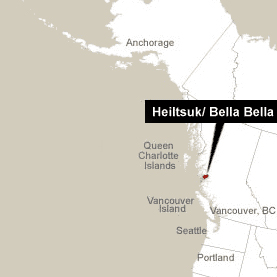
“Originally our ancestors occupied more than 50 major villages spread across our vast territory. They used the intricate network of waterways to travel from well-established winter villages to numerous seasonal camps situated on salmon streams, along ancient trading routes, and on far-flung outer islands. When Europeans arrived in the eighteenth century there were several Heiltsuk villages on the various islands near the present-day location of Bella Bella.
In 1833 the Hudson’s Bay Company established Fort McLoughlin, a heavily fortified fur trading post, on what is now McLoughlin Bay on Campbell Island. The Heiltsuk already had a well-established trading network on the coast, but the Hudson’s Bay Company sought to supplant indigenous people as middlemen in the the fur trade wherever possible. Still, the officers at Fort McLoughlin found the Heiltsuk would not allow themselves to be pushed aside.
Despite initial hostilities, within a few years a new Heiltsuk village was established in close proximity to Fort McLoughlin. The Heiltsuk became well known as skilled and savvy traders and developed a lucrative, if uneasy, business relationship with the fort.
The Heiltsuk knew the village as ’Qélc, but Europeans recorded various other names for the village, perhaps derived from the local geographical name Pélbála, that eventually gave rise to the modern English name Bella Bella. Members of Heiltsuk-speaking tribes from across the region who gradually relocated to the village over the next sixty years became known as the Bella Bella Indians.
 Heiltsuk oral tradition states that the original Heiltsuk ancestors were set down by the Creator in various areas in the territory now referred to as the Central Coast of British Columbia, before the time of the great flood. An archeological excavation and study of ancient remains based in a Heiltsuk Village site of Namu in the 1960’s and 1970’s concluded that the history of the Heiltsuk go back as far as 11,500 years.
Heiltsuk oral tradition states that the original Heiltsuk ancestors were set down by the Creator in various areas in the territory now referred to as the Central Coast of British Columbia, before the time of the great flood. An archeological excavation and study of ancient remains based in a Heiltsuk Village site of Namu in the 1960’s and 1970’s concluded that the history of the Heiltsuk go back as far as 11,500 years.
We affirm Gvi’ilas, the laws of our ancestors as the paramount principle to guide all resource use and environmental management. According to Chief Moses Humchitt, Gvi’ilas refers to our “power” or authority over all matters that affect our lives. It is a complex and comprehensive system of laws that embodies values, beliefs, teachings, principles, practices, and consequences. Inherent in this is the understanding that all things are connected and that unity is important to maintain.
Gvi’ilas has been described as the ethos of our people: “Gvi’ilas not only governed our relationship and responsibilities to land and resources, but also social relationships and obligations with respect to lands and resources. For example, take a little and leave a lot; dispersed and varied resource harvesting obligations to share and support family and community; obligations to care for the resource; seeing all aspects of harvesting, from the taking of the resources to the methods used, as a gift of the Creator.”
Furthermore, Gvi’ilas governs our relationships with both the temporal and spiritual worlds: “Relationships with and use of natural resources were rooted in a value system that ensured sustainability and respect. It was believed that all living matter had a spiritual essence that was respected, and interconnectedness was understood. Each family was given responsibility over specific land and water bases. Sustainable use and management was enforced by certain practices and teachings. Plants were gathered in a specific way. The first salmon caught was blessed with ritual ceremony that acknowledged its sacrifice and need to give sustenance to our people. Communication with the spirit of the land, sea and its life forms was common through respect and prayer.”
Source: Text Copyright of the Heiltsuk Nation webpage
